29.12.2017
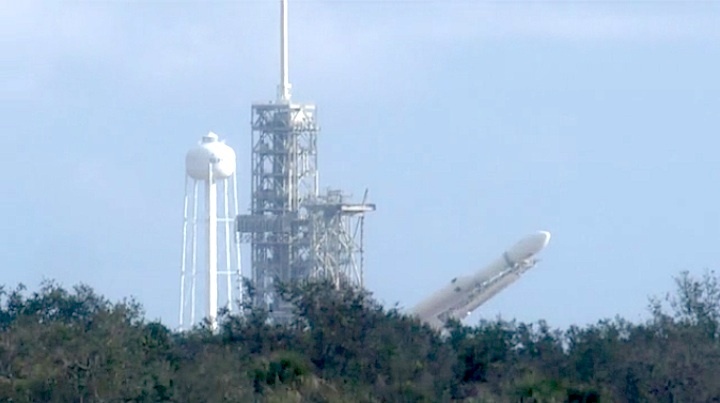
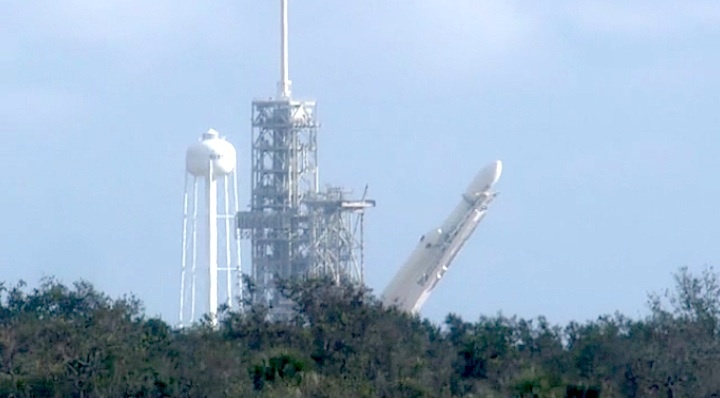
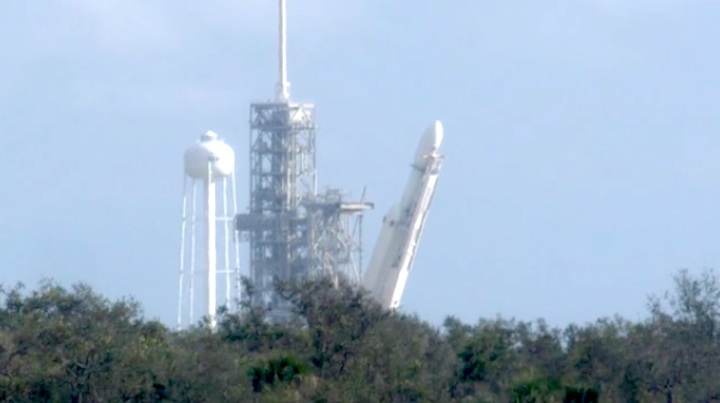
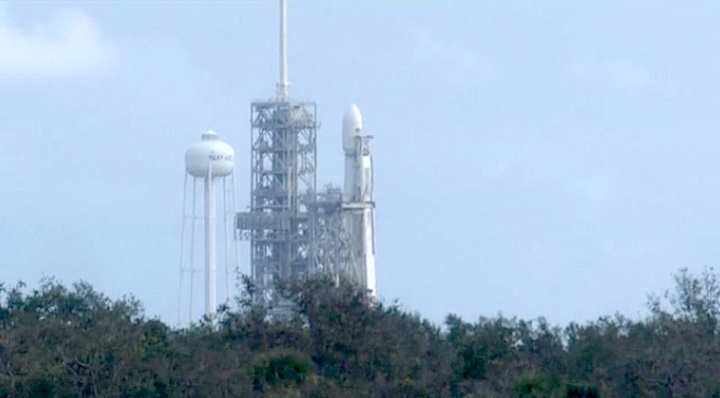
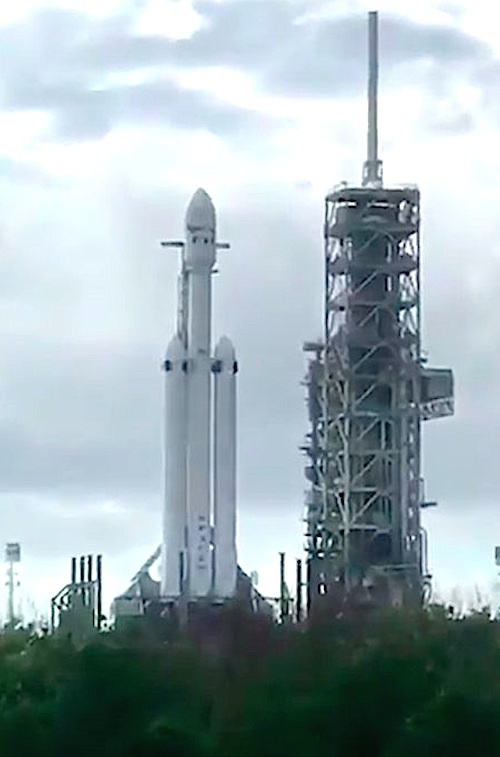
Watch a time-lapse video as the Falcon Heavy goes vertical at launch pad 39A on December 28, 2017. The video runs at 34 times normal speed. This video is made possible by the generous support of Spaceflight Now members. Join today. We appreciate your support.
-
SpaceX’s first Falcon Heavy rocket, made up of two previously-flown Falcon 9 boosters and a beefed up central core stage, made the trip to launch pad 39A at NASA’s Kennedy Space Center in Florida and was raised vertical Thursday for testing ahead of its first liftoff next month.
The fully-assembled 229-foot-tall (70-meter) rocket will be the most powerful in the world when it blasts off, and Thursday’s arrival atop pad 39A marks a major step toward readying the Falcon Heavy for flight.
SpaceX engineers are expected to conduct a fit check and complete other tests at pad 39A this week, followed by a hold-down firing of all 27 first stage engines some time after New Year’s Day. The company has not set a target date for the Falcon Heavy’s first liftoff, but officials say the launch is targeted in January, some time after the hold-down hotfire test.
Become a Spaceflight Now member to watch live video of the Falcon Heavy at pad 39A.
The Falcon Heavy’s inaugural test launch will have a dummy payload on-board, but SpaceX has readied a flashier, more colorful passenger than the boilerplates and water ballast carried on previous test flights of new heavy-lift launchers.
SpaceX founder and chief executive Elon Musk decided to place one of his Tesla Roadsters on-board the Falcon Heavy, a cherry red creation from Musk’s electric car company.
The Falcon Heavy will attempt to give the automobile enough speed to escape the grasp of Earth’s gravity, sending it into a heliocentric solar orbit that will take it to the approximate distance of Mars from the sun.
When it blasts off next month, the heavy-lifter will generate about 4.7 million pounds of thrust at launch. Musk said the first Falcon Heavy’s engines will be throttled to 92 percent of full power.
That will make the Falcon Heavy the most powerful rocket flying today, exceeding the European Ariane 5 launcher, the world’s leader in liftoff power at 2.9 million pound of thrust from two segmented solid rocket boosters and a core engine. SpaceX’s new rocket will produce more thrust than any launch vehicle since the space shuttle.
The Falcon Heavy will also be able to carry more payload into orbit than any other rocket in the world, a more important measure of the rocket’s lifting capacity.
The Delta 4-Heavy rocket, operated by SpaceX rival United Launch Alliance, can haul up to 63,471 pounds (28,790 kilograms) to a low-altitude orbit approximately 120 miles (200 kilometers) above Earth when launched to the east from Cape Canaveral, according to a launch vehicle data sheet published by ULA.
When its first stage boosters are not recovered, SpaceX’s Falcon Heavy will be capable of delivering up to 140,660 pounds (63,800 kilograms) to low Earth orbit when launched to the east from Florida’s Space Coast, where rockets get a velocity boost from Earth’s rotation.
But SpaceX intends to land all three first stage boosters on the Falcon Heavy, eating into the rocket’s propellant reserves and reducing the weight it can loft into orbit.
For the maiden flight next month, the Falcon Heavy’s two side boosters, recovered and modified from Falcon 9 flights in 2016, will cut off and return to Cape Canaveral Air Force Station for near-simultaneous landings. The center core, a newly-built booster, will head for landing on SpaceX’s floating platform in the Atlantic Ocean.
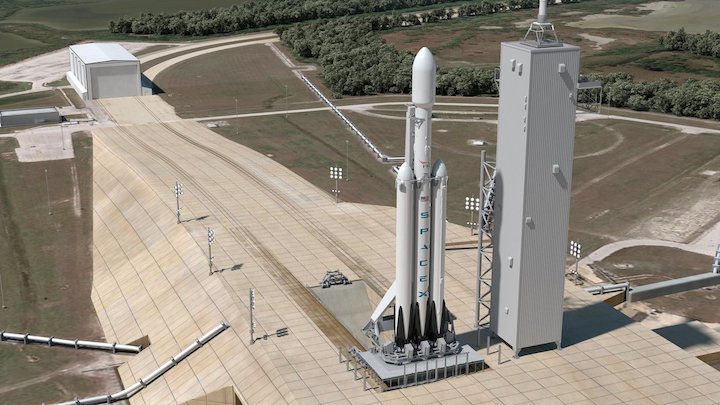
Quelle: SN
+++
FALCON HEAVY
When Falcon Heavy lifts off in 2018, it will be the most powerful operational rocket in the world by a factor of two. With the ability to lift into orbit over 54 metric tons (119,000 lb)--a mass equivalent to a 737 jetliner loaded with passengers, crew, luggage and fuel--Falcon Heavy can lift more than twice the payload of the next closest operational vehicle, the Delta IV Heavy, at one-third the cost. Falcon Heavy draws upon the proven heritage and
reliability of Falcon 9. Its first stage is composed of three Falcon 9 nine-engine cores whose 27 Merlin engines together generate more than 5 million pounds of thrust at liftoff, equal to approximately eighteen 747 aircraft. Only the Saturn V moon rocket, last flown in 1973, delivered more payload to orbit. Falcon Heavy was designed from the outset to carry humans into space and restores the possibility of flying missions with crew to the Moon or Mars.


PAYLOAD
Falcon Heavy missions will deliver large payloads to orbit inside a composite fairing, but the rocket can also carry the Dragon spacecraft.
COMPOSITE FAIRING
The composite payload fairing protects satellites during delivery to destinations in low Earth orbit (LEO), geosynchronous transfer orbit (GTO) and beyond.
Composite fairing after separation.
SECOND STAGE
Falcon Heavy draws upon Falcon 9’s proven design, which minimizes stage separation events and maximizes reliability. The second-stage Merlin engine, identical to its counterpart on Falcon 9, delivers the rocket’s payload to orbit after the main engines cut off and the first-stage cores separate. The engine can be restarted multiple times to place payloads into a variety of orbits including low Earth, geosynchronous transfer orbit (GTO) and geosynchronous orbit (GSO).
- ENGINE
- 1
- BURN TIME
- 397sec
- THRUST IN VACUUM
- 934kN210,000 lbf
FIRST STAGE
Three cores make up the first stage of Falcon Heavy. The side cores, or boosters, are connected at the base and at the top of the center core’s liquid oxygen tank. The three cores, with a total of 27 Merlin engines, generate 22,819 kilonewtons (5.13 million pounds) of thrust at liftoff. Shortly after liftoff the center core engines are throttled down. After the side cores separate, the center core engines throttle back up to full thrust.
- CORES
- 3
- ENGINES
- 27
- THRUST AT SEA LEVEL
- 22,819kN5,130,000 lbf
- THRUST IN VACUUM
- 24,681kN5,548,500 lbf
BOOSTERS
Each of Falcon Heavy’s side cores, or boosters, is equivalent to the first stage of a Falcon 9 rocket with nine Merlin engines. At liftoff, the boosters and the center core all operate at full thrust. Shortly after liftoff, the center core engines are throttled down. After the side cores separate, the center core engines throttle back up.
THREE NINE-ENGINE CORES
Inside each of Falcon Heavy’s three cores is a cluster of nine Merlin engines. These same engines power Falcon 9, enabling efficiencies that make Falcon Heavy the most cost-effective heavy-lift launch vehicle in the world. With a total of 27 first-stage engines, Falcon Heavy has engine-out capability that no other launch vehicle can match—under most payload scenarios, it can sustain more than one unplanned engine shutdown at any point in flight and still successfully complete its mission.

FAIRING
SpaceX’s payload fairing, a composite structure fabricated in-house by SpaceX, protects satellites during delivery to low-Earth orbit (LEO), geosynchronous transfer orbit (GTO) and beyond.
GRID FINS
Falcon Heavy’s first stage is equipped with hypersonic grid fins which manipulate the direction of the stage’s lift during reentry.
FALCON HEAVY STRUCTURE
The tanks of Falcon Heavy’s three first-stage cores and second stage are made of aluminum-lithium alloy, a material made stronger and lighter than aluminum by the addition of lithium.
LANDING LEGS
Falcon Heavy was designed to be fully reusable. Both the center core and side boosters carry landing legs, which will land each core safely on Earth after takeoff.
OCTAWEB
The twenty-seven Merlin engines that power Falcon Heavy's three cores are arranged in an Octaweb structure, with eight engines surrounding one center engine on each core.
MERLIN ENGINE
The Merlin engine that powers all three Falcon Heavy cores was developed internally by SpaceX, drawing upon a long heritage of space-proven engines. A key design at the heart of Merlin was first used for the Apollo lunar landing module.
Quelle. SpaceX
+++
SpaceX's three-core Falcon Heavy rolls out to KSC launch pad
SpaceX Falcon Heavy flight animation. The rocket will be the most powerful in the world when it lifts off from Kennedy Space Center in 2018.
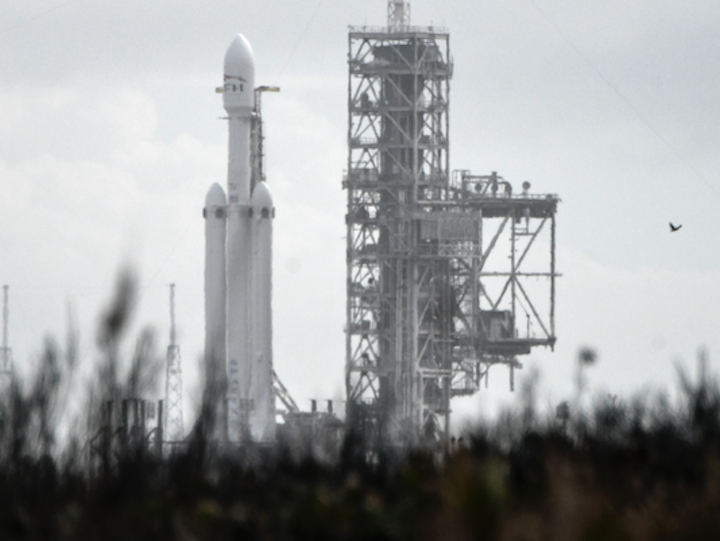
Encapsulated in the rocket's nose cone, however, isn't a typical payload: CEO Elon Musk is sending his red 2008 Tesla Roadster to deep space as part of the demonstration flight. Expect David Bowie's "Space Oddity" to be playing on the all-electric sports car's sound system before launch, he said.
When the 40-foot-wide Falcon Heavy lifts off, its 5.1 million pounds of thrust will make it the most powerful rocket in the world – and the most powerful to launch from pad 39A since the storied Saturn V rocket of the Apollo era.
After liftoff, all three of its 156-foot-tall boosters are expected to descend for landings – the two side cores at Cape Canaveral Air Force Station's Landing Zone 1, and the center core on the Of Course I Still Love You drone ship stationed in the Atlantic Ocean.
That means Space Coast spectators can expect a doubling of the dramatics typically involved in a Falcon 9 landing, including twice the sonic boom energy when the boosters cross the speed-of-sound threshold.
Falcon Heavy promises to lift heavier payloads to higher orbits, which could lead to more lucrative contracts for SpaceX. The company advertises crewed trips to the moon or Mars as being within its capabilities, too.
Quelle: Florida Today
---
Warum der Falcon-Heavy-Raketenstart ein Ereignis der Superlative wird
Ufo-Alarm in Los Angeles: Helles Licht und seltsame Rauchwolken erleuchteten kürzlich den Himmel über Los Angeles. In den sozialen Netzen wurde heiß diskutiert, wer hinter dem unbekannten Flugobjekt über Kalifornien stecken könnte.
Der Multiunternehmer Elon Musk konnte darüber nur lächeln. Er heizte scherzhaft per Twitter die Spekulationen noch mit dem makabren Scherz an, es handele sich womöglich um ein „nukleares außerirdisches Ufo aus Nordkorea“. Wenig später erklärte Musk die Himmelserscheinung dann mit dem Start einer Rakete seiner Raumfahrtfirma SpaceX. Also kein Grund, sich aufzuregen, lautete die Botschaft. Außerdem stünde ein gewaltiges Himmelsspektakel erst noch bevor. Musk versprach, mit dem ersten Start seiner Falcon-Heavy-Rakete alles bisher Gesehene in den Schatten zu stellen.
Tatsächlich wird die nun für Januar geplante Premiere der Falcon Heavy ein in der Raumfahrtgeschichte einmaliges Ereignis der Superlative. Und das in mehrfacher Hinsicht: Mit Blick auf die Technik der Rakete, die geplante Rückkehr von drei Raketenstufen zur Erde sowie der Nutzlast – einem roten Tesla-Sportwagen, der durch den Weltraum in Richtung Mars fliegen soll.
Es kann viel schiefgehen
Weil Musk schon im Vorfeld des Starts mehrfach davon gesprochen hat, dass beim Erstflug der Falcon Heavy „sehr viel schiefgehen kann“, bewegen sich die Premienerwartungen zwischen zwei Extremen: Im besten Fall klappt der Start der dann weltweit schubstärksten Rakete. Die Mission würde zum Doppelhöhepunkt für die Musk-Unternehmen SpaceX, für die Raumfahrt und Tesla als Elektroautofirma mit einer Werbeaktion für den Roadster.
Im schlechtesten Fall scheitert der Start von der historischen Startplattform im Kennedy Space Center in Florida – von der bereits die Saturn-Rakete zur ersten Mondlandung abhob. Kommt es zur Explosion, wäre es einer der größten Unfälle auf dem Nasa-Weltraumbahnhof.
Sportwagen auf Mars-Mission
Zu den Besonderheiten der Rakete gehört, dass die erste Antriebsstufe wiederverwendet werden kann. Das soll Kosten sparen. Die Falcon Heavy ist also keine Wegwerfrakete, deren erste Stufe ausgebrannt irgendwo im Meer versinkt oder wie bei den Russen in einer Steppe aufschlägt. Vereinfacht dargestellt sind bei der Falcon Heavy beim Start drei Antriebsstufen des aktuellen Modells Falcon 9 gebündelt.
Zwei davon, genutzt als seitliche Booster, sollen nach dem Verbrauch ihres Treibstoffs auf ihrer Flugbahn im Weltraum umkehren. Sie sollen zurück zum Startplatz in Florida fliegen und dort auf Landebeinen senkrecht nahezu parallel wieder aufsetzen. Erwartet werden spektakuläre Live-Bilder aus den Raketenstufen.
Die zentrale erste Stufe soll auf einer schwimmenden Plattform im Atlantik ebenfalls sanft landen – während die Oberstufe weiter in den Weltraum fliegt und den roten Sportwagen in Flugrichtung Mars abliefert.
Rakete startet mit 27 Triebwerken
Die technische Glanzleistung mit dem Rückflug von Raketenstufen aus dem All auf Landeplätze an Land oder auf Meeresplattformen wurde von SpaceX bereits 19 Mal erfolgreich demonstriert. Aber noch nie wurde das Manöver im Dreierpack versucht.
Zu den Besonderheiten der Rakete gehört auch die unglaubliche Zahl von drei mal neun, also 27 Triebwerken, die beim Start nahezu gleichzeitig gezündet werden. Keine US-Rakete hatte jemals mehr Triebwerke. Die Zündung der Triebwerke im Abstand von Millisekunden gilt als eine der großen technischen Herausforderungen.
Elon Musk hat bereits im Vorfeld erklärt, dass beim Start alles Mögliche schiefgehen kann. „Es ist durchaus möglich, dass sie es nicht bis zum Orbit schaffen wird. Aber ich hoffe, dass die Rakete hoch genug von der Startrampe abhebt, um sie nicht zu beschädigen.“
Die 70 Meter hohe Rakete habe einen Maximalschub von 5,1 Millionen Pfund oder 2300 Tonnen. Der Schub sei vergleichbar mit der Kraft von 18 Boeing Jumbojets, erläutert Musk. Die Falcon Heavy könne bis zu 63 Tonnen in eine niedrige Erdumlaufbahn befördern – oder mit knapp 17 Tonnen bis zum Mars fliegen. Nur die 1973 ausrangierte Saturn-V-Mondrakete habe größere Gewichte ins Weltall transportiert.
Riesenwerbeaktion für Tesla
Mehr Triebwerke als die Falcon Heavy hatte nur die gigantische sowjetische Mondrakete N-1 Herkules, mit der Moskau eigentlich den Wettlauf zum Mond gegen die USA gewinnen wollte. Die Entwicklung der Rakete mit 30 Triebwerken endete aber dramatisch. Bei vier Starts zwischen Februar 1969 und November 1972 gab es vier Fehlschläge. Die Explosion einer N-1 im Juli 1969 kurz nach dem Start gehört zu den größten Raumfahrtunfällen in der Geschichte der Raumfahrt. Der Startplatz in Baikonur in Kasachstan wurde dem Erdboden gleichgemacht.
Ein solches Desaster will Elon Musk mit seiner Falcon Heavy auf jeden Fall auf dem Nasa-Weltraumbahnhof vermeiden. Noch ist das genaue Startdatum im Januar nicht bekannt, aber die Sicherheitsvorkehrungen werden gewaltig sein. In Expertenkreisen wird es als cleverer Schachzug gewertet, in die Raketenspitze keine kommerzielle Nutzlast zu packen. Stattdessen wird die Marsmission mit Tesla an Bord zur Riesenwerbeaktion für den Elektroautobauer.
Zu oft hat es bei Raketenpremieren Fehlschläge gegeben. Beispielsweise zerbrach Europas Ariane-5-Rakete beim Erstflug 1996 in der Luft und wurde gesprengt.
Kritiker verweisen darauf, dass die Falcon Heavy bereits 2013 starten sollte, also etwa fünf Jahre hinter dem Zeitplan liegt. Musk hatte im Gegenzug darauf verwiesen, dass die technischen Herausforderungen größer als zunächst erwartet waren und Entwicklerkapazitäten auch für seine aktuelle Rakete Falcon 9 gebraucht wurden.
Es gibt Raketenreservierungen aus Saudi-Arabien
Die Startkosten für eine Falcon Heavy beziffert SpaceX auf rund 90 Millionen Dollar – für einen Satelliten auf einer geostationären Umlaufbahn. Wie bei SpaceX und anderen Raketenanbietern üblich, gibt es ohnehin keine volle Preistransparenz. Je nach Missionsprofil sollen auch nicht alle drei ersten Startstufen der Rakete wiederverwendet werden.
Beim Premierenstart wird zwar noch kein zahlender Kunde die Rakete nutzen, aber es gibt bereits Reservierungen. So hat Saudi-Arabien eine Mission mit einem Telekommunikationssatelliten vorgemerkt. Zu den Kunden gehört auch das Pentagon zur Erprobung neuer Weltraumtechnik.
Klappt alles nach Plan, soll die von SpaceX entwickelte Raumkapsel Dragon 2 mit zwei Weltraumtouristen bereits Ende 2018 zu einem Flug um den Mond abheben – an der Spitze einer Falcon Heavy. Noch hat Elon Musk nicht verkündet, wer mit seiner Superrakete starten soll. Es wäre ohnehin ein unglaublich ambitionierter Zeitplan zwischen dem Premierenflug, bei dem ein Auto zum Mars geschickt wird und einer bemannten Mondumkreisung.
Quelle: Die Welt
+++
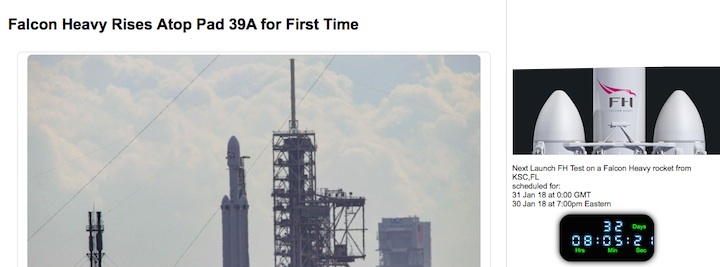
----
Update: 1.01.2018
.
Falcon Heavy preparing for Static Fire test
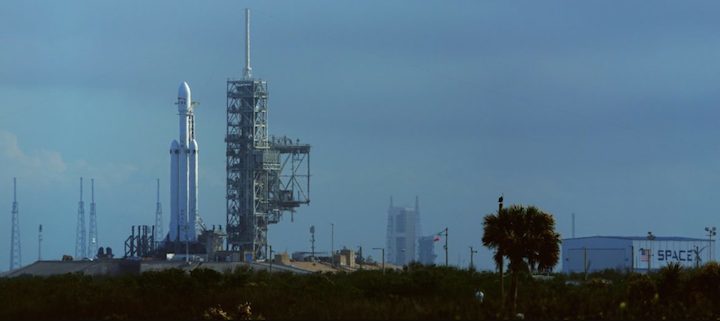
SpaceX has been ticking off the milestones towards the maiden flight of its Falcon Heavy rocket, with the latest achievement resulting in the vehicle making her first trip to the launch pad. Via a process known as “Fit Checks”, this flow milestone allows for a test run of rollout and erection on Pad 39A ahead of another upcoming first, the Static Fire test involving the ignition of all 27 engines.
Falcon Heavy has been a long time in the making, as is usually the case for most new rockets. Signs the impressive renders and fascinating videos were close to becoming a reality stepped up a gear when hardware for this maiden flight started to make appearances out in the open.
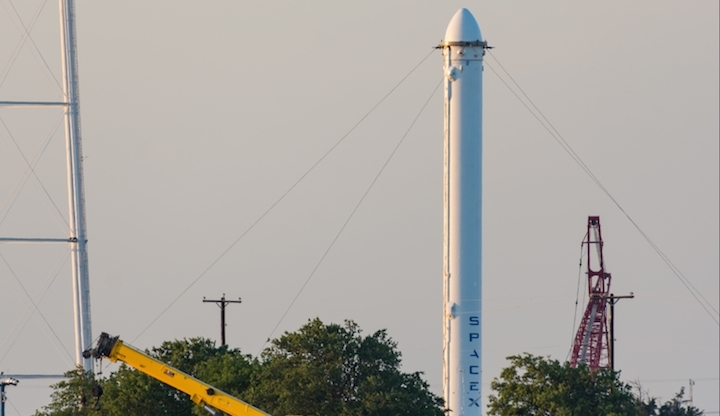
With the side boosters undergoing testing at SpaceX’s McGregor test site in Texas, obvious due to their aerodynamic nose cones, preparations on the hardware began to pick up the pace during testing opportunities that did not impact on SpaceX’s regular launch manifest with its Falcon 9 rocket.
Falcon Heavy’s main propulsion consists of two flight-proven cores for the side-mounted boosters (boosters B1023.2 and B1025.2) and a new core for the central core (booster B1033).
That center core also paid a visit to McGregor for a full duration static fire test.
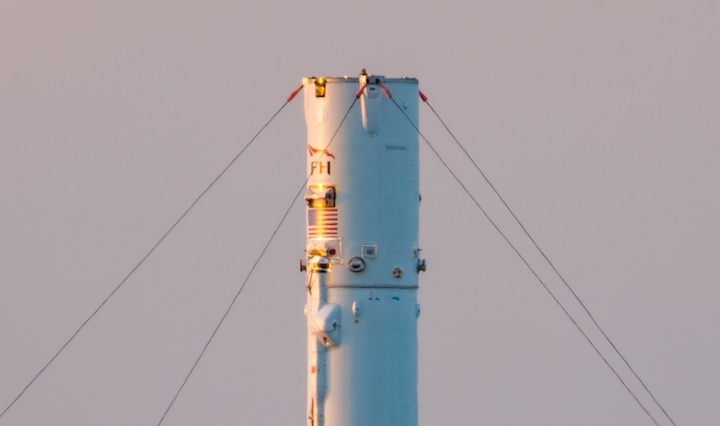
These three boosters finally arrived at SpaceX’s 39A Horizontal Integration Facility (HIF) at the Kennedy Space Center to undergo final checks and mating procedures. The HIF at KSC’s historic pad was purpose-built to host both Falcon Heavy and Falcon 9 flows at the same time.
They were joined by the upper stage and the fairing, sporting the Falcon Heavy logo.
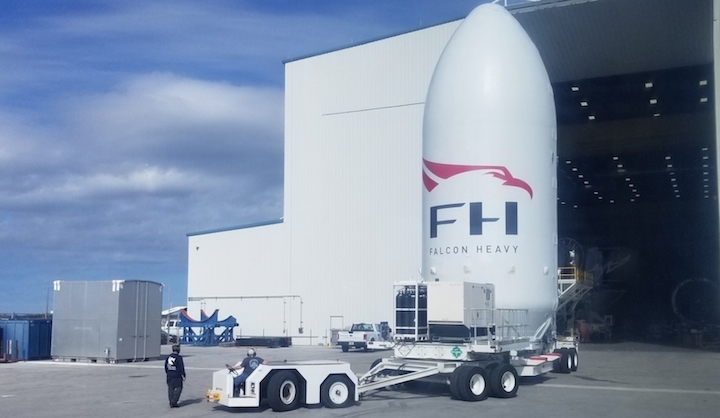
Although the potential of launching before the end of the year – as Elon Musk had previously noted was the hope – was lost, SpaceX did manage to achieve a major milestone over the holidays with the rollout of the full stack to 39A.
Riding on the modified Transporter/Erector/Launcher (TEL), which is now capable of launching both Falcon 9 and Falcon Heavy, as originally envisioned, the huge rocket finally graced 39A, standing proud as the most powerful all-liquid propulsion rocket to sit on the former Apollo and Shuttle pad since the Saturn V in the 1970s.
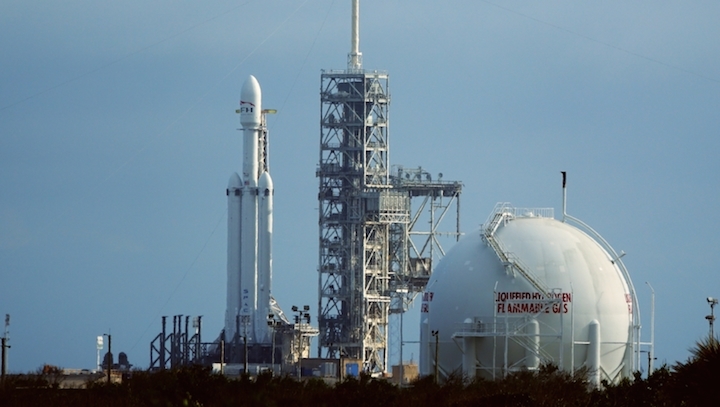
This flow was for the “Fit Checks” a new rocket usually undergoes to provide data on rollout and erection at the pad. This was the first time the modified TEL had taken the full stack to the pad.
No propellant loading was conducted, although the vehicle may have been “powered on” to aid the checkouts. “Power On” is one of the first items on the checklist for a launch day.
24 hours later the rocket was lowered back to horizontal and will now head into the flow for its Static Fire test.
This test is currently expected to take place on January 6, although – as always – these dates can move around due to numerous factors such as readiness, range authority and weather.
One driving factor that directly relates to this preliminary target date is the upcoming launch of the secretive Zuma spacecraft, which is currently targetting January 4 following a lengthy delay relating to a since-cleared concern with the fairing.
This launch, providing there isn’t another large slip, is the near-term priority for SpaceX. Once launched, the focus will return to Falcon Heavy Static Fire test.
It was originally understood SpaceX would first conduct a Wet Dress Rehearsal (WDR) on the rocket to test prop loading and the characteristics of the rocket before attempting to fire up her engines. However, it is now likely SpaceX will treat the day as a full Static Fire test.
This will make sense as any issues that may prevent the ignition of the engines would still allow for good data to be gathered as if it was just a WDR. By the same token, an issue-free WDR would provide the opportunity to take that extra step and run the test through to ignition.
The Static Fire test will be a new challenge in itself, with engineers having to monitor 27 – as opposed to nine – engines, all of which will have their own vast amount of data on their health and performance.
It is likely that due to this amount of data, even the “Quick Look” review will take some time before SpaceX classes the test as a full success.
Due to the number of engines, Falcon Heavy will follow an ignition sequence similar to the Space Shuttle, employing a staggered start sequence – like main engine start on Shuttle – where each main engine started 120 milliseconds after the previous.
It is understood that two Merlin 1D engines will be lit simultaneously followed by the next two… and so on until all 27 are up and running, providing a controlled ramp up to full power for the business end of the vehicle.
While the key Launch Readiness Review (LRR) will be another obvious milestone ahead of setting the launch date, this maiden flight is likely to undergo several levels of reviews at the hardware and executive level before SpaceX is comfortable with providing the green light to press to launch day.
Based on Range bookings, no date has yet been officially filed, although several sources cite a preliminary window opening on January 15. However, rocket fans should be cautioned against using this date to book flights, given the absolute importance of conducting a successful Static Fire test.
Quelle: NS
---
Update: 5.01.2018
.
SpaceX will launch ‘most powerful rocket in the world’ this month, and with a Tesla on board
- SpaceX will launch its biggest rocket, called the Falcon Heavy, this month, CEO Elon Musk said
- SpaceX claims the Falcon Heavy is the "most powerful rocket in the world by a factor of two"
- Musk also revealed that the rocket would carry out a test fire next week
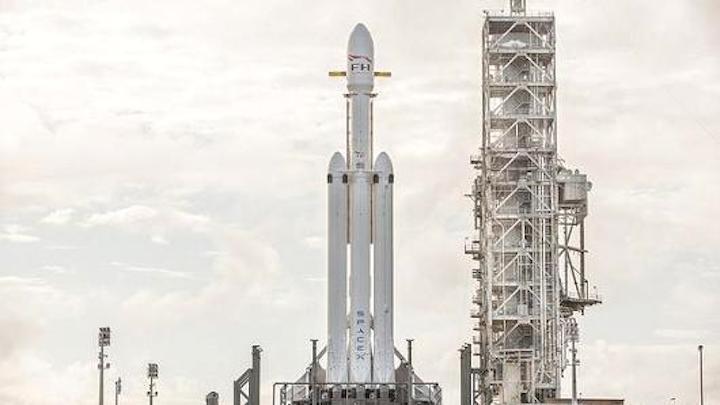
SpaceX will launch its biggest rocket yet, called the Falcon Heavy, at the end of the month, Chief Executive Elon Musk announced on social media late Thursday.
The billionaire's space exploration company claims the Falcon Heavy is the "most powerful rocket in the world by a factor of two." Musk said in an Instagram post Thursday that, at 2,500 tons of thrust, the rocket is equivalent to 18 Boeing 747 aircraft at full throttle.
Musk also revealed that the rocket would carry out a test fire next week with a full launch at the end of the month. Until now, there was no date set for the launch.
The Falcon Heavy has suffered multiple delays. Last year, Musk admitted that the development of the rocket had been "way harder" than he had anticipated.
For the test flight, the rocket will not carry a customer's payload. Instead, Musk will launch an original Tesla Roadster playing David Bowie's "Space Oddity" into "a billion year elliptic Mars orbit." Musk is also CEO of Tesla.
SpaceX does have some customers for the Falcon Heavy lined up, however. These include satellite firms Arabsat and Inmarsat, and the U.S. Air Force. There are no concrete dates for these launches.
The Falcon Heavy test will take place at the Kennedy Space Center's Launch Complex 39A.
SpaceX has been ramping up its launches. The company's rockets are able to take a payload to space then land back on a droneship in the sea so they can be reused. SpaceX said that this reduces the cost of flights and allows it to do more frequent launches. It aims to launch a payload every two weeks.
The company is currently gearing up to launch a classified U.S. government payload codenamed "Zuma" this weekend.
Quelle: CNBC

